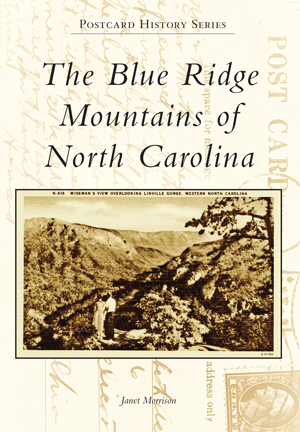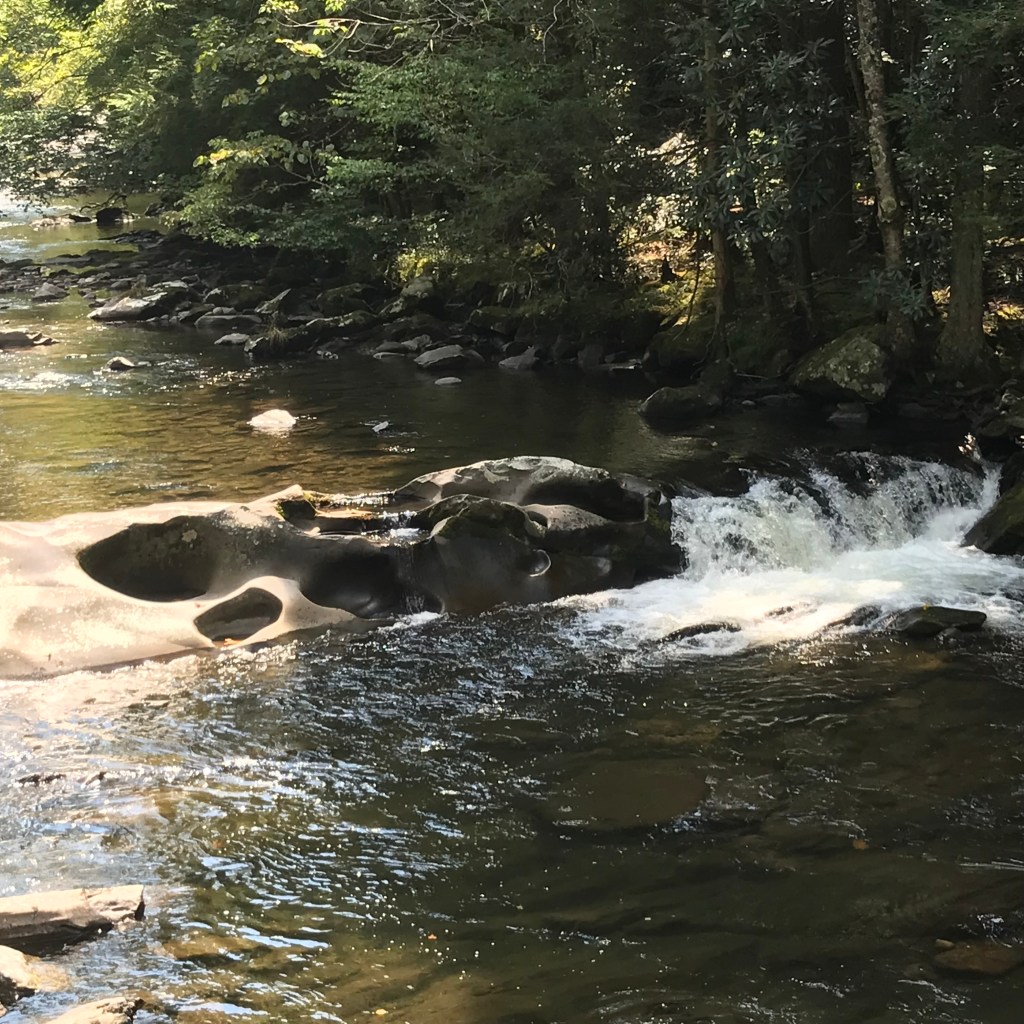
Several weeks ago I took a vacation from blogging, writing, and all social media. It was wonderful! I hope you can try it sometime.
My sister and I spent a week in and around the Great Smoky Mountains National Park in Tennessee and North Carolina.
For seven days, I didn’t check my blog for comments. I didn’t text. I didn’t call anyone. I didn’t Tweet. It was fabulous!
“The Great Smoky Mountains lay in the middle of the Cherokee Indians’ territory in the mid-1600s when Spanish explorer Hernando de Soto arrived.”
page 69, The Blue Ridge Mountains of North Carolina, by Janet Morrison.


Since the park was included in my vintage postcard book, The Blue Ridge Mountains of North Carolina, I enjoy visiting the park to see what has changed and what has remained the same since my childhood and since my book’s publication in 2014.
Today and next Monday, I’ll share some highlights from my trip, including a few of the pictures I took. I’ll also include photographs of some of the vintage postcards from my book, which is pictured to the right.
Elk!
Elk were reintroduced into the Great Smoky Mountains in 2001 and 2002. I’d never seen an elk until this recent trip! What a thrill it was to see a herd of elk, including this buck, in the river that runs behind the Oconoluftee Visitor Center near the main North Carolina entrance to Great Smoky Mountains National Park just north of Cherokee, NC! This bull was a jaw-dropping sight as he surveyed his herd of female elk (cows) cooling off in this cool mountains stream. (It was late afternoon and in the mid-90s F.)

It is illegal to willingly get within 150 feet of an elk or black bear in Great Smoky Mountains National Park. Don’t worry, I was behind a fence that was guarded by a park ranger, and I used the zoom feature on my cell phone camera.

For more information about the reintroduction of elk in Great Smoky Mountains National Park and the safeguards people should take when seeing them, go to https://www.nps.gov/grsm/learn/nature/elk.htm.
The Loop/Helix
One of the most famous construction features on US-441/Newfound Gap Road, which traverses Great Smoky Mountains National Park from one side to the other is “The Loop.” The highway tunnels under itself to form a helix.
Here are pictures of two of the three postcards of “The Loop” in my vintage postcard book.


The next two paragraphs are quotes from the captions I wrote for the three postcards on pages 80-81 of my book:
“Newfound Gap Road in Great Smoky Mountains National Park tunnels under itself, forming a helix. The design replaced two dangerous switchbacks on the old Tennessee Highway 71, which was built in the 1920.”

“These black-and-white glossy real-photo postcards were made in 1936. The Great Smoky National Park Roads & Bridges portion of the Historic American Engineering Record of the National Park Service gives many details about the Loop. Probably designed by Charles Peterson, the Loop was constructed in 1935 by C.Y. Thomason Company of Greenwood, South Carolina, at a cost of $77,644. Stone quarried nearby and reinforced concrete were used in the construction of the bridge portion, which is 95 feet long, 42 feet wide, and 21 feet high in the center of the arch.”
Since its construction in 1935, trees and other natural vegetation has been allowed to grow and flourish. I appreciate that; however, it makes it almost impossible now to fully see and admire this engineering feat. It might still be possible to see the entire Loop from Chimney Tops Mountain nearby, but it’s impossible to get a satisfactory photograph of it from ground level due to the trees. Therefore, I had to settle for the above picture of The Loop signage.
The first time I rode through The Loop was at the age of nine. It’s still a thrill, 57 years later!
Babbling Brooks

One of my favorite features in Great Smoky Mountains National Park is all the babbling brooks. Little River Road runs parallel to the Little River for many miles in the park between Sugarlands Visitor Center and Cades Cove. Little River and the other streams in the park are full of bounders and rocks of all sizes, indicating the history of these mountains from the Ice Age.

Since my last blog post
It took much patience and persistence (and some grinding of my teeth), but I eventually worked out a new way of inserting photographs in my blog posts last Tuesday. What a relief, to be able to present today’s post and next Monday’s the way I had envisioned! I hope you enjoy the photographs today.
I had the opportunity to watch and listen to another free webinar about the craft of writing on Monday. It was about Author Accelerator’s “Inside Outline” tool. It piqued my interest. Of course, to use the tool I’d have to pay a fee, so I haven’t made that commitment. If you, like I, are learning to write a book, you might want to look into this tool at https://www.authoraccelerator.com/. The tool was developed by Jennie Nash.
Until my next blog post
I hope you have a good book to read. I’m reading The Ragged Edge of Night, by Olivia Hawker.
If you’re a writer, I hope you have productive writing time.
Thank you for reading my blog. You could have spent the last few minutes doing something else, but you chose to read my blog.
Watch for my blog post next Monday. It is a continuation of today’s post and will feature black bears, the double-peaked mountain called Chimney Tops, damage from the late November 2016 wildfires, babbling brooks, white clouds down in a valley one morning, and why the Great Smoky Mountains have that moniker.
A few words about my book
I hate to “blow my own horn.” I’d be remiss, though, if I didn’t take this opportunity to tell you how you can have your own copy of my vintage postcard book, The Blue Ridge Mountains of North Carolina, published by Arcadia Publishing in 2014.
Don’t let the name of the book fool you, it covers all the mountainous counties in western North Carolina and the three counties in eastern Tennessee that are partially in Great Smoky Mountains National Park. Electronic and paperback copies are available from Amazon.com at https://www.amazon.com. Paperback copies are available from the publisher at https://www.arcadiapublishing.com/, at quality bookstores, or from me personally.
Let’s continue the conversation
Have you visited the Great Smoky Mountains? If so, what were your impressions of it? What was the highlight of your trip? Did you see any black bears? Did you see elk? Did you hike? Did you go camping? The recreational opportunities in the Great Smoky Mountains are unlimited! I’d love to hear about your experiences there.
Also, please let me know how you usually view my blog. Do you look at it on your desktop computer, on a tablet, or on your phone?
I’m trying to be more cognizant of the fact that a growing number of people are reading blogs on their phones. The layout of the blog translates differently on the various formats.
For instance, what looks good on a cell phone, doesn’t look quite as good on a desktop computer. Today’s blog post falls into that category. I’ve spent a lot of time on it, trying out “spacers” and “separators.” I’ve never used those tools before. Your patience is appreciated as I learn and experiment with some new blogging techniques.
Remember, I’m a writer — not a computer whiz. This is all part of my journey as a writer, which is what my blog is about.
Thank you for sharing my blog with your friends — in person and on social media!
Janet
